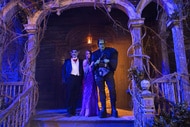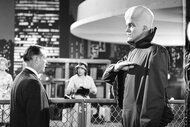Create a free profile to get unlimited access to exclusive videos, sweepstakes, and more!
Emmy Contender: Amazon's Hanna changed the movie's look, going dirty and teen-centric

The 2011 film Hanna — with its trippy cinematography and pulsating score — placed its titular heroine (played by Saoirse Ronan) inside a heightened reality: The movie was a surreal fairy tale more than a standard action thriller. The new Hanna TV show shares a number of things with its predecessor: the secret government program, the father figure (now Joel Kinnaman) raising young Hanna (now played by Esme Creed-Miles) in the wilderness where he trains her in the lethal arts of an assassin.
But the Amazon series based on the movie is much more realistic, thanks in large part to cinematographer Dana Gonzales (Legion, Fargo), who discussed his visual strategies with SYFY WIRE.
Hanna, the film, was shot by a German DP and it had a very German aesthetic — influenced by fairy tales as well as directors like Werner Herzog and Rainer Fassbinder, shot at Studio Babelsberg, with plenty of bright lights. This is more dimly lit. What kind of conversations did you have about the different take?
Well, I was a fan of the movie. I loved the movie. And I actually referenced that movie on several other projects that I did over the years. And then when I had the opportunity to shoot the first two hours of this show — Episodes 1 and 2 — that was an exciting thing. But it's almost impossible to copy the original. You don't have the same actors. You don't have the same budget. There are so many factors you don't have.
In the second episode, when she's escaping the underground facility, there's definitely an homage to what they did, with the flashing lights. They used a really great score to emphasize the flashing lights. We have that, too, but maybe not to the same level as they took it. The cave, where Hanna and her father live, I love what they did, but our world's a little different. Theirs was super-polished, a very production-designed space, and I wanted to make it super-organic: candle-lit, fire-lit, a little more rustic and real. Our cave, it looks like they really went into a cave and over the years, scrapped together stuff. Our fight scene was in the forest, and theirs was in a more open space, by an ice lake. But even so, the shots that build up to the fight, running through the forest, are very close to the movie.
But the director, Sarah Adina Smith, was really not interested much in the tone of the movie, so that made matching the tone not important. So we kind of reconstructed it and made it about the way a 16-year-old girl sees the world before and after her integration into society.
How did that determine how you shot it?
In the pilot, it's her upbringing in the wilderness, and you don't really see her go out into the real world until Episode 2. We wanted her upbringing in the wilderness to be kind of clean and unobstructed, and so we chose really sharp, clean lenses to be a contrast with what the rest of the show would be. When she left the forest, we used vintage lenses that had more flares and were a little more dirty compared to a modern lens. The movie was shot with a very sharp, modern tone, and we wanted to differentiate from that, and try to emphasize the camera angles from Hanna's perspective, to show how she sees the world. I don't know if that was the motivation in the movie, but that's what drove us, basically.
I know the show also shows the perspective of the father and the people chasing Hanna, but we wanted viewers to be immersed in Hanna's world, to be able to jump in and out of that easily. The movie did do that on some level, for sure, and I had to reference the movie a couple times to illustrate story points. It's the same writer — David Farr, who co-wrote the movie — and so there are definitely some parallels.
But to be honest, if I'm looking at the film, there are some places I felt like they didn't go far enough. I really love texture and tone, and I always try to throw in a lot of atmosphere. I definitely went after the tone of Scandinavian dramas, because I want to be transported to a different place. Like in Episode 2, when Hanna comes out of the government facility, we see this orange-y color, in complete contrast to the forest and the facility itself. The film didn't do that, but that's the emotional place where I want the audience to be. I like the weight of it. And in the movie, when they extracted her from the forest, I thought that was a little too normal. I wanted it to be heavier. I wanted you to feel like you're really deep into the forest. I wanted it to look like European films, not a homogenized American version.
How dark is too dark?
I've read some reviews where people are like, "Oh, it's a little dark." Okay. But I think it's fine. I think that more people like that than don't like that. And sometimes the story is taking place at night, or in early morning light, and I always want to feel the progression of time and space. Sometimes, even big films miss that. So I was really happy that I could put that spin on it.
What were some of your biggest challenges on this shoot?
Anytime you shoot in snow — and we were in the mountains of Slovakia, and there was a lot of snow that winter — that's a challenge. A big part of that episode is in the wilderness. We were hiking to places, putting up cranes, so hopefully, when Hanna's on the end of a massive cliff, it feels more magical.
And that helicopter landing with the soldiers? We literally had 45 minutes to shoot that entire sequence. And those are some beautiful shots — soldiers coming out towards the camera, then taking Hanna to the helicopter, and then we're inside a helicopter. All in 45 minutes. But it doesn't feel rushed when you have a spirited director who's willing to go for it.




























